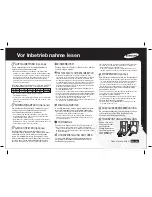
Defrosting
A) Fridge compartment
The fridge compartment defrosts automatically.
The defrost water runs to the drain tube via a
collection container at the back of the appliance
(Fig. 4)
.
During defrosting, water droplets may form at
the back of the fridge compartment where a
concealed evaporator is located. Some droplets
may remain on the liner and refreeze when
defrosting is completed. Do not use pointed or
sharp-edged objects such as knives or forks to
remove the droplets which have refrozen.
If, at any time, the defrost water does not drain
from the collection channel, check that no food
particles have blocked the drain tube. The drain
tube can be cleared with a pipe-cleaner or
similar implement.
B) Freezer compartment
Defrosting is very straightforward and without
mess, thanks to a special defrost collection
basin.
Defrost twice a year or when a frost layer of
around 7 (1/4") mm has formed. To start the
defrosting procedure, switch off the appliance
at the socket outlet and pull out the mains plug.
All food should be wrapped in several layers
of newspaper and stored in a cool place (e.g.
fridge or larder).
Containers of warm water may be placed
carefully in the freezer to speed up the defrosting.
Do not use pointed or sharp-edged
objects, such as knives or forks to
remove the frost.
Never use hair dryers, electrical heaters
or other such electrical appliances for
defrosting.
Sponge out the defrost water collected in the
bottom of the freezer compartment. After
defrosting, dry the interior thoroughly.
(Fig. 5-6)
Insert the plug into the wall socket and switch
on the electricity supply.
Replacing the interior
light bulb
Should the light fail, switch off at the socket
outlet and pull out the mains plug.
Then ensure the bulb is screwed securely in the
bulb holder. Replace the plug and switch on.
If the light still fails, obtain a replacement E14
screw-cap type 15 Watt (Max) bulb from your
local electrical store and then fit it
(Fig. 3)
. Carefully dispose of the burnt-out light
bulb immediately.
Cleaning and care
1.
We recommend that you switch off the
appliance at the socket outlet and pull out the
mains plug before cleaning.
2.
Never use any sharp instruments or abrasive
substances, soap, household cleaner, detergent
or wax polish for cleaning.
3.
Use lukewarm water to clean the cabinet of
the appliance and wipe it dry.
4.
Use a damp cloth wrung out in a solution
of one teaspoon of bicarbonate of soda to one
pint of water to clean the interior and wipe it
dry.
5.
Make sure that no water enters the
temperature control box.
6.
If the appliance is not going to be used for
a long period of time, switch it off, remove all
food, clean it and leave the door ajar.
7.
We recommend that you polish the metal
parts of the product (i.e. door exterior, cabinet
sides) with a silicone wax (car polish) to protect
the high quality paint finish.
8.
Any dust that gathers on the condenser,
which is located at the back of the appliance,
should be removed once a year with a vacuum
cleaner.
9.
Check door seals regularly to ensure they
are clean and free from food particles.
10.
Never:
• Clean the appliance with unsuitable material;
Instruction Manual
GB
6
Summary of Contents for KSM 1640
Page 1: ......
Page 2: ......
Page 3: ...1 3 5 4 7 11 12 10 10 10 9 1 15 13 14 17 16 4 8 6 2 14 ...
Page 4: ...3 2 6 4 5 ...
Page 5: ...7 25 24 26 1 6 3 17 18 23 2 4 4 19 19 16 45 8 5 180 20 21 22 22 7 9 10 27 27 12 13 14 11 15 ...
Page 82: ......
Page 83: ......
Page 84: ......
Page 85: ......
Page 86: ......
Page 87: ......
Page 88: ......
Page 89: ......
Page 90: ......











































